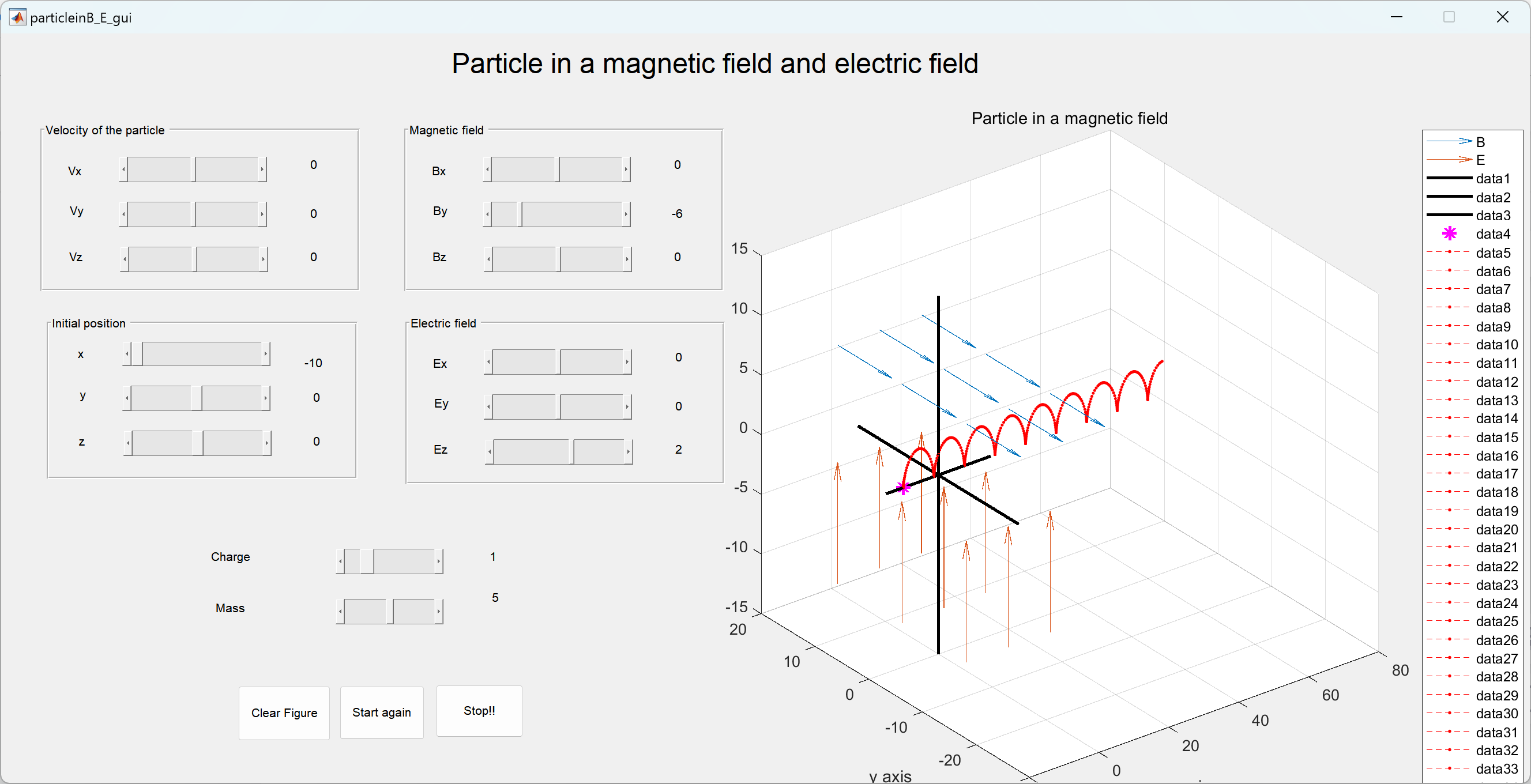目录
💥1 概述
-
模拟粒子在电场和磁场中的轨迹研究是物理学中的一个重要研究领域,涉及到电磁场、粒子运动、轨迹分析等多个方面。在这个研究中,通过数值模拟的方法,可以模拟粒子在电场和磁场中的运动轨迹,以及粒子的速度、加速度等物理量的变化规律。这种模拟方法可以帮助研究人员更好地理解粒子在电磁场中的运动规律,以及电磁场对粒子的影响。
在模拟粒子在电场和磁场中的轨迹研究中,需要考虑粒子的电荷、质量、速度等因素,以及电场和磁场的强度、方向等因素。通过数值模拟的方法,可以计算出粒子在电场和磁场中的受力情况,从而确定粒子的运动轨迹。在模拟过程中,需要使用数值计算方法,例如欧拉法、龙格-库塔法等,来求解微分方程,以模拟粒子的运动。
模拟粒子在电场和磁场中的轨迹研究在物理学、电子学、材料科学等领域都有广泛的应用。例如,在核物理学中,可以通过模拟粒子在电磁场中的运动轨迹,来研究核反应、核裂变等现象;在电子学中,可以通过模拟电子在电场和磁场中的运动轨迹,来研究电子器件的性能和特性;在材料科学中,可以通过模拟粒子在电磁场中的运动轨迹,来研究材料的电学、磁学等性质。
模拟粒子在电场和磁场(电磁场)中的轨迹。轨迹是通过计算求解微分方程来计算的。磁场和电场的方向和大小可以随着运动的其他属性而改变。
📚2 运行结果

部分代码:
Edit the above text to modify the response to help particleinB_E_gui
% Last Modified by GUIDE v2.5 17-Jun-2011 05:04:25
% Begin initialization code - DO NOT EDIT
gui_Singleton = 1;
gui_State = struct('gui_Name', mfilename, ...
'gui_Singleton', gui_Singleton, ...
'gui_OpeningFcn', @particleinB_E_gui_OpeningFcn, ...
'gui_OutputFcn', @particleinB_E_gui_OutputFcn, ...
'gui_LayoutFcn', [] , ...
'gui_Callback', []);
if nargin && ischar(varargin{1})
gui_State.gui_Callback = str2func(varargin{1});
end
if nargout
[varargout{1:nargout}] = gui_mainfcn(gui_State, varargin{:});
else
gui_mainfcn(gui_State, varargin{:});
end
% End initialization code - DO NOT EDIT
% --- Executes just before particleinB_E_gui is made visible.
function particleinB_E_gui_OpeningFcn(hObject, eventdata, handles, varargin)
% This function has no output args, see OutputFcn.
% hObject handle to figure
% eventdata reserved - to be defined in a future version of MATLAB
% handles structure with handles and user data (see GUIDATA)
% varargin command line arguments to particleinB_E_gui (see VARARGIN)
% Choose default command line output for particleinB_E_gui
handles.output = hObject;
🎉3 参考文献
部分理论来源于网络,如有侵权请联系删除。
-
Griffiths, D. J. (2017). Introduction to Electrodynamics (4th ed.). Cambridge University Press.
-
Reitz, J. R., Milford, F. J., & Christy, R. W. (1992). Foundations of Electromagnetic Theory (4th ed.). Addison-Wesley.
-
Jackson, J. D. (1999). Classical Electrodynamics (3rd ed.). Wiley.
-
Goldstein, H. (1980). Classical Mechanics (2nd ed.). Addison-Wesley.
-
Purcell, E. M., & Morin, D. J. (2013). Electricity and Magnetism (3rd ed.). Cambridge University Press.
-
Wang, Y., & Li, Y. (2018). Numerical simulation of charged particle motion in electric and magnetic fields. Journal of Physics: Conference Series, 1065(1), 012008.
-
Zhang, Y., & Li, Y. (2019). Numerical simulation of charged particle motion in electric and magnetic fields using the Runge-Kutta method. Journal of Physics: Conference Series, 1236(1), 012008.
-
Wang, Y., & Li, Y. (2020). Numerical simulation of charged particle motion in electric and magnetic fields using the Euler method. Journal of Physics: Conference Series, 1519(1), 012008.






















 8546
8546











 被折叠的 条评论
为什么被折叠?
被折叠的 条评论
为什么被折叠?








